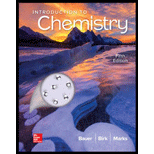
Concept explainers
(a)
Interpretation:
The balanced chemical equation and the reaction type is to be determined for the given chemical equation.
(a)
Explanation of Solution
The chemical equation that is shown below is balanced because the number of atoms on the left side is equal to the number of atoms on the right side.
This
(b)
Interpretation:
The balanced chemical equation and the reaction type are to be determined for the given chemical equation.
(b)
Explanation of Solution
The skeleton equation for the chemical equation is shown below, where on the left side, the number of atoms is not equal to the number of atoms on the right side.
To balance the chemical equation, the coefficient for
This reaction is a single-displacement reaction because calcium replaces the hydrogen from the water molecule and forms calcium hydroxide.
(c)
Interpretation:
The balanced chemical equation and the reaction type are to be determined for the given chemical equation.
(c)
Explanation of Solution
The chemical equation that is shown below is balanced because the number of atoms on the left side is equal to the number of atoms on the right side.
This chemical reaction is a single-displacement reaction in which a carbon atom is replaced from its chemical compound by nitrogen.
(d)
Interpretation:
The balanced chemical equation and the reaction type are to be determined for the given chemical equation.
(d)
Explanation of Solution
The skeleton equation for the chemical equation is shown below, where on the left side, the number of atoms is not equal to the number of atoms on the right side.
To balance the chemical equation, the coefficient for
(e)
Interpretation:
The balanced chemical equation and the reaction type are to be determined for the given chemical equation.
(e)
Explanation of Solution
The chemical equation that is shown below is balanced because the number of atoms on the left side is equal to the number of atoms on the right side.
This chemical reaction is a decomposition reaction in which ammonium chloride decomposes into ammonia and hydrochloric acid.
(f)
Interpretation:
The balanced chemical equation and the reaction type is to be determined for the given chemical equation.
(f)
Explanation of Solution
The chemical equation that is shown below is balanced because the number of atoms on the left side is equal to the number of atoms on the right side.
This chemical reaction is a combination reaction in which calcium sulfate is formed when calcium oxide and sulfur trioxide combine.
(g)
Interpretation:
The balanced chemical equation and the reaction type are to be determined for the given chemical equation.
(g)
Explanation of Solution
The chemical equation that is shown below is balanced because the number of atoms on the left side is equal to the number of atoms on the right side.
This chemical reaction is a decomposition reaction in which phosphorus pentachloride is decomposed on heating.
(h)
Interpretation:
The balanced chemical equation and the reaction type are to be determined for the given chemical equation.
(h)
Explanation of Solution
The skeleton equation for the chemical equation is shown below, where on the left side, the number of atoms is not equal to the number of atoms on the right side.
To balance the chemical equation, the coefficients for
Want to see more full solutions like this?
Chapter 5 Solutions
Introduction To Chemistry 5th Edition
- Please help me with number 1-3. Thank you so much.arrow_forwardDraw the major product of this reaction ingnore the inorganic byproducts. 1. NaOCH2CH3 at 25 C 2. PhCH2Br (1 eq)arrow_forwardAt 90ºC the vapor pressure of ortho-xylene is 20 kPa and that of meta-xylene is 18 kPa. What is the composition of the vapor in equilibrium with a mixture in which the mole fraction of o-xylene is 0.60?arrow_forward
- Draw the products of this reduction of a ketone with sodium borohydride. Use a dash or wedge bond to indicate the stereochemistry of substituents on asymmetric centers, where applicableIgnore any inorganic byproducts. 1) NaBH4 2) HCI/H2O Select to Drawarrow_forwardWhy do you think people who live at high altitudes are advised to add salt to water when boiling food like pasta? What mole fraction of NaCl is needed to raise the boiling point of H2O by 3˚C? Does the amount of salt added to water (typically about one teaspoon to four quarts of water) substantially change the boiling point? (Kb (H2O) = 0.51˚C/molal.)arrow_forwardpls help asaparrow_forward
- pls help asaparrow_forward9. Consider the following galvanic cell: Fe (s) | Fe(NO3)2 (aq) || Sn(NO3)2 (aq) | Sn (s) a. Write an equation for the half reactions occurring at the anode and cathode. b. Calculate the standard cell potential Show all of your work. c. Draw and label the galvanic cell, including the anode and cathode, direction of electron flow, and direction of ion migration.arrow_forwardpls help asaparrow_forward
- 11. Use the equation below to answer the following questions: 2 Al(s) + 3 Cd(NO3)2 (aq) → 2 Al(NO3)3 (aq) + 3 Cd(s) a. What is the net ionic equation for the reaction? b. Which species is a spectator ion in this reaction? Define a spectator ion. c. Identify the oxidizing agent and the reducing agent.arrow_forwardpls help asaparrow_forwardpls help asaparrow_forward
 Chemistry & Chemical ReactivityChemistryISBN:9781337399074Author:John C. Kotz, Paul M. Treichel, John Townsend, David TreichelPublisher:Cengage Learning
Chemistry & Chemical ReactivityChemistryISBN:9781337399074Author:John C. Kotz, Paul M. Treichel, John Townsend, David TreichelPublisher:Cengage Learning Chemistry: The Molecular ScienceChemistryISBN:9781285199047Author:John W. Moore, Conrad L. StanitskiPublisher:Cengage Learning
Chemistry: The Molecular ScienceChemistryISBN:9781285199047Author:John W. Moore, Conrad L. StanitskiPublisher:Cengage Learning Chemistry for Engineering StudentsChemistryISBN:9781337398909Author:Lawrence S. Brown, Tom HolmePublisher:Cengage Learning
Chemistry for Engineering StudentsChemistryISBN:9781337398909Author:Lawrence S. Brown, Tom HolmePublisher:Cengage Learning Chemistry & Chemical ReactivityChemistryISBN:9781133949640Author:John C. Kotz, Paul M. Treichel, John Townsend, David TreichelPublisher:Cengage Learning
Chemistry & Chemical ReactivityChemistryISBN:9781133949640Author:John C. Kotz, Paul M. Treichel, John Townsend, David TreichelPublisher:Cengage Learning ChemistryChemistryISBN:9781305957404Author:Steven S. Zumdahl, Susan A. Zumdahl, Donald J. DeCostePublisher:Cengage Learning
ChemistryChemistryISBN:9781305957404Author:Steven S. Zumdahl, Susan A. Zumdahl, Donald J. DeCostePublisher:Cengage Learning Chemistry: An Atoms First ApproachChemistryISBN:9781305079243Author:Steven S. Zumdahl, Susan A. ZumdahlPublisher:Cengage Learning
Chemistry: An Atoms First ApproachChemistryISBN:9781305079243Author:Steven S. Zumdahl, Susan A. ZumdahlPublisher:Cengage Learning





